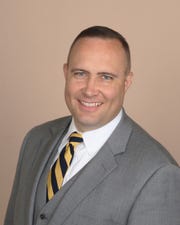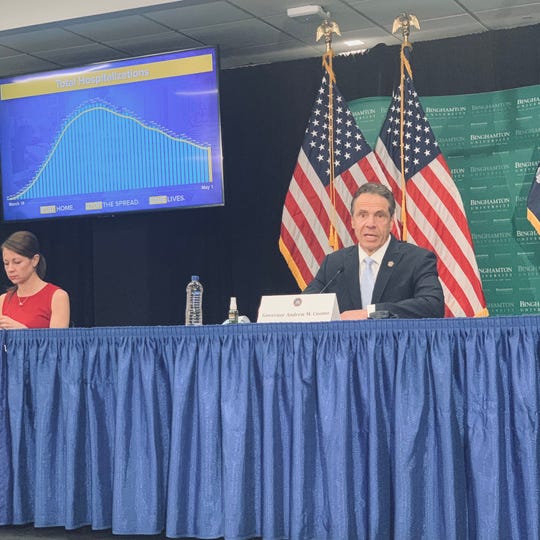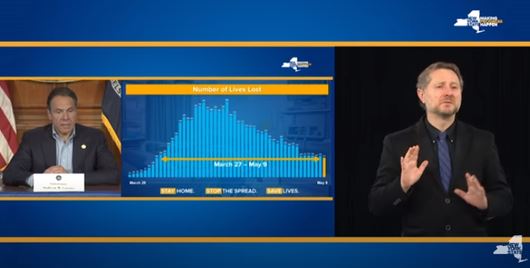Jon Campbell, New York State Team
Published 3:37 p.m. ET May 14, 2020 | Updated 6:23 p.m. ET May 14, 2020
Democrat & Chronicle
ALBANY – The newest star of New York Gov. Andrew Cuomo’s coronavirus briefings has never been in the same room as the governor himself.
The huge television audience that tunes in to Cuomo’s daily press conference was introduced to Arkady Belozovsky for the first time Tuesday.
Belozovsky has been offering American Sign Language interpretation of Cuomo’s briefings from a remote studio each day since March 27, when the governor’s office first began broadcasting an ASL feed on the state’s website.
But May 13 marked a major breakthrough for the deaf community: Belozovsky was added to the main feed beamed out to television broadcasters, including CNN, MSNBC and local stations across the state.
The change, ordered by a federal judge only after advocates for the deaf sued Cuomo, made New York the 50th state to offer sign-language interpretation of its coronavirus briefings on a television feed.
And now Belozovsky — a Rochester Institute of Technology graduate who left the former USSR with his family at age 16 — has been thrust into a starring role, appearing in a picture-in-picture box alongside Cuomo for briefings that attract broad viewership across the nation.
“Today is the 13th,” Belozovsky said Wednesday, a few hours after Cuomo’s briefing. “People say unlucky number 13? For me, it’s lucky number 13. I’m thrilled that it started today.”
Interpreter knows the deaf community well
Belozovsky, 46, has a personal understanding of what quality American Sign Language interpretation means to members of the deaf community.
He is deaf himself.
Belozovsky, who grew up in what is now Ukraine, is a third-generation deaf person. Three of his four children are also deaf; the fourth is hard of hearing.
A member of a Jewish family, he came to the U.S. with his parents and sister at the age of 16, fed up with the anti-Semitism he experienced under the USSR regime.
After attending Edward R. Murrow High School in Brooklyn, Belozovsky went to college at the Rochester Institute of Technology, picking up a master’s degree in linguistic and interactive multimedia development in 1999 after graduating with his bachelor’s degree two years prior.
He is what’s known as a Certified Deaf Interpreter, a high-level certification from the Registry of Interpreters for the Deaf for interpreters who are deaf or hard of hearing.
CDIs are fluent in American Sign Language and add the use of gesture and miming to convey nuance, style and more — skills Belozovsky expertly uses each day to convey Cuomo’s outer-borough dialect and the tone of his message.
Some of the gestures are subtle. When Cuomo speaks of the federal government, Belozovsky points up, for example.
Others are more distinct: When a reporter asks a question or a member of Cuomo’s cabinet speaks, Belozovsky shifts his shoulders to signify someone other than the governor is speaking.
“You’re taking on the persona of three or four different characters all at a rapid pace so that deaf people can get a clear picture,” Belozovsky said through an interpreter Wednesday. “We’re using facial expressions to match the tone of the governor’s remarks.”
Long commute for Belozovsky, feed interpreter
Each day, Belozovsky travels two hours each way from his home in Massachusetts to a remote studio in Albany’s Empire State Plaza complex to interpret Cuomo’s briefings. The studio is apart from Cuomo, who in recent days has been traveling the state.
Because he is deaf, Belozovsky relies on a second interpreter sitting out of view of the camera — a “feed interpreter,” he calls it — to convey what the governor is saying to him.
Belozovsky, wearing a dark shirt or suit in front of a black backdrop to better highlight his face and hands, then interprets for the television audience, using his high-level, theatrical blend of signing and facial expressions to accurately convey the governor’s message.
“You talk about wanting to do your very best to be accurate, not only in content but in tone,” said Jeff Harris, one of two feed interpreters working with Belozovsky in Albany.
“This is not your normal press conference. It’s not Republicans and Democrats agree to a new budget. It’s the coronavirus and we’re billions of dollars in the hole because of all this. The stakes are higher.”
 Pastor of the Anchor Baptist Church in Hilton, Monroe County, Harris travels back and forth to Albany from the Rochester area a few times a week to interpret the feed for Belozovsky.
Pastor of the Anchor Baptist Church in Hilton, Monroe County, Harris travels back and forth to Albany from the Rochester area a few times a week to interpret the feed for Belozovsky.
Photo: Jeff Harris, pastor of the Anchor Baptist Church near Rochester, travels to Albany a few times a week to provide ‘feed interpretation’ of Gov. Andrew Cuomo’s coronavirus briefings. (Photo: Provided by Jeff Harris)
He switches off days with Dale Neimeyer, an Albany-based interpreter who also works with Belozovsky.
Harris, who can hear, interpreted Belozovsky’s interview Wednesday with the USA TODAY Network New York. He is the child of deaf parents and his siblings are deaf. American Sign Language is his native language.
One door closes; another opens
 Photo: Arkady Belozovsky, a Certified Deaf Interpreter, interprets New York Gov. Andrew Cuomo’s daily coronavirus briefings. (Photo: Screengrab via NYS Governor’s Office)
Photo: Arkady Belozovsky, a Certified Deaf Interpreter, interprets New York Gov. Andrew Cuomo’s daily coronavirus briefings. (Photo: Screengrab via NYS Governor’s Office)
Belozovsky had become an in-demand interpreter in the New England states over the past 28 years. He has been a full-time freelancer in recent years, including the past four years for many press conferences held by Rhode Island Gov. Gina Raimondo.
His work for Raimondo garnered a profile in the Providence Journal and on local television. But by mid-March, his relationship with the Rhode Island Commission for the Deaf and Hard of Hearing seemed to have gone quiet.
By Belozovsky’s telling, the commission gradually began using a new interpreter, someone who was a Rhode Island resident. By mid-March, Belozovsky’s services were no longer needed.
Earnest Covington III, the Rhode Island commission’s executive director, declined to discuss the specifics of Belozovsky’s situation, citing confidentiality. The commission strives to “utilize various interpreting teams in response to community feedback,” he said.
Suddenly, Belozovsky was in the same position as millions across the country as the coronavirus continued its torrid spread: Out of work, wondering when his next paycheck would come.
“Never in my whole life professionally did I have no work for five days,” he said. “I was under a lot of stress. How am I going to pay the bills? I don’t qualify for unemployment. And then this door opened up.”
That door was the state of New York.
Cuomo, facing pressure, hires interpreter

Photo: New York Gov. Andrew Cuomo speaks at the Binghamton University College of Pharmacy in Johnson City on Tuesday, May 12, 2020. (Photo: Ashley Biviano / Binghamton Press & Sun-Bulletin)
At the same time Belozovsky was out of work, Cuomo’s daily coronavirus briefings were reaching new heights of popularity, aided by the cable news networks broadcasting them live each day.
The governor was facing increasing criticism from the deaf community for failing to offer sign-language interpretation. By late March, Cuomo’s office agreed to add an interpreter; An interpreter firm soon contacted Belozovsky.
On March 27, Belozovsky interpreted his first Cuomo briefing. He hasn’t missed a day since.
At one point, Rhode Island did inquire about his services again. But Belozovsky said his travel complicated matters because Rhode Island was ordering New York travelers (and later all out-of-state travelers) to self-quarantine for 14 days at one point, a policy that drew the ire of Cuomo.
David Wantuck, community engagement specialist for Buffalo-based Deaf Access Services, said Belozovsky has been doing a “phenomenal” job.
Wantuck, who is deaf, was among the advocates who publicly pressed Cuomo to add sign-language interpretation.
“He is presenting Governor Cuomo’s message very well,” Wantuck, speaking through an interpreter, said of Belozovsky’s work.
“The voice intonation shows in the body language, and that is very critical. Deaf people can’t hear that verbal emotion, and Arkady has been expressing that emotion visually so that we can connect with the tone of the message.”
Advocates for the deaf say there’s more to be done
Wantuck and Belozovsky said there’s plenty more work to be done, however.
The ASL interpretation was only added to Cuomo’s television feed after Disability Rights New York, an advocacy group, filed a federal lawsuit against him, arguing that he was violating federal law meant to protect the disabled from discrimination.
U.S. District Judge Valerie Caproni of Manhattan agreed with the group, ordering Cuomo to add Belozovsky to the television frame.
That happened Wednesday. But Belozovsky was placed in a small frame toward the bottom right of the screen for most of Cuomo’s briefing, a placement that was occasionally obscured by logos on some television stations.
That was unlike Cuomo’s prior online feed, when Belozovsky took up about a third of the screen and Cuomo and his PowerPoint presentation took up the other two thirds.
“My inbox exploded with the excitement and disappointed comments from the deaf community that a decision was made to put the interpreter in that small box in the lower right hand corner that low-vision deaf people and older deaf people can’t see,” Belozovsky said Thursday. “When they have the headlines that go across, it obstructs their view of the interpreter.”
By Thursday, Belozovsky’s frame was moved up a bit to try to account for the logo issue.
But advocates for the deaf have called on Cuomo to have the frame cover at least 25% of the screen in accordance with World Federation of the Deaf guidelines.
“The next step is to educate and improve the visual part of what is on the screen,” Wantuck said. “We really do appreciate the (picture-in-picture) now. It is a start. But it’s not the end goal.”





